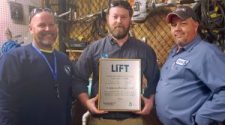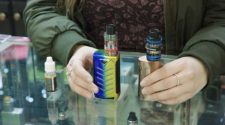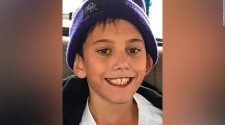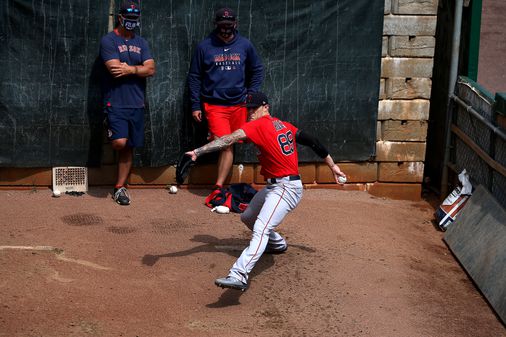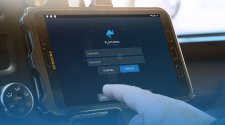It was an atypical year, but not necessarily a lost one.
“I think this season, the year, whatever you’d call it — this non-season, this time — has continued to present opportunities for guys to develop,” said Red Sox farm director Ben Crockett. “I really do think that looking back, we will absolutely see guys that took significant steps forward in that time between when the public last saw them at the end of 2019 and they next see them in 2021.
“I really do think that development has continued. Every part of it doesn’t require games, every part of it doesn’t require a watchful eye.”
So how did the Red Sox and their minor leaguers spend the last seven months?
Staying connected
Initially, when minor leaguers were sent home, no one knew how long they’d be gone. There was initial hope that the diaspora might last just a few weeks, but that quickly faded. It wasn’t long before players and officials recognized that the minor league season would be delayed and quite possibly canceled.
The Red Sox, said Crockett, wanted their minor leaguers to take a “stay-ready” approach. The organization communicated with the players to determine their individual circumstances — whether a player had a throwing partner, weights in the house, private access to a gym. From there, the organization’s strength-and-conditioning staff concocted programs for players to stay in shape — and in some cases, to improve it.
Each player was assigned to a strength coach and trainer, and usually had at least weekly check-ins. The team has apps that its minor leaguers use — one for general communication, another for the players to self-report workout. — both in-season and during the offseason. Those became natural mechanisms for staying in touch and tracking work.
The medical staff checked on physical well-being and discussed COVID-19 safety protocols. The mental skills staff likewise reached out to players regularly.
“We made a really explicit attempt to make sure everyone was doing OK . . . just to make sure everyone had the support they needed and that things were going well,” said Crockett. “It was challenging everyone, certainly with baseball but, more importantly, outside of that.”
As the team waited for clarity about when the season might start, team officials conducted remote learning seminars for the professional development of staff members. As the shutdown extended, the organization expanded those to include Zoom sessions for players. The first were led by the mental skills staff and served primarily to restore a measure of familiar contact.
“It was good to hop on, talk, and just see the other guys — talk with them, see what they were up to,” said outfielder Tyler Dearden. “You’re used to being around the guys every day. In the quarantine, it was cool to hop on and just talk.”
Over time, the team began conducting remote-learning programs to focus on skill development and understanding of the game. Coaches organized sessions on pitching, hitting, defense, and baserunning.
“For instance, one of our Zoom calls was the importance of getting ahead with strike one, getting us the information, the statistics that show how much of an advantage it is being 0-1 instead of 1-0, things like that,” said starting pitcher Thad Ward. “We were able to really discuss things openly, trust the fact that we weren’t being judged at all by our teammates.”
The discussions proved useful, and gave the Sox ideas for further such programs. Nonetheless, there’s only so much that could be accomplished through them.
“It’s not the same,” Red Sox pitching coordinator Ralph Treuel said during the summer. “As much as I look forward to talking to the pitchers once or twice a week, it doesn’t replace talking to them in the bullpen with a baseball in our hands.”
Baseball with no teams
In the absence of their team context, players had varying levels of access to baseball activities. One pitcher, for instance, was limited to throwing into a net in his basement. He was the exception, though, as most players found one or more peers with whom to stay sharp.
Ward, who is from Fort Myers, Fla., worked out with Austin Rei, a Red Sox catcher who has reached Double A Portland. Rei gave him valuable feedback on the shape of his pitches, particularly a changeup that the righthander is working to develop.
“It helps a lot having another perspective, having someone else to see it, said Ward, “and that way you can adjust the feel of the pitch based on what they see.”
While working with Rei, Ward did what he could to visualize game situations.
“I visualized going against a certain batter, simulating, ‘OK, it’s a lefty with a low swing plane who likes the ball out over the plate,’ ” said Ward. “That determines how I attack the hitter, and I’d execute off my plan of attack.”
Dearden spent time at a high school field taking batting practice with his father. Eventually, the outfielder started meeting with fellow clients of agent Jeff Randazzo — who co-owns an indoor/outdoor sports institute — to get at-bats against professional pitchers.
“It was kind of like a summer ball league,” said Dearden. “It was really cool . . . I probably would have gotten 400 at-bats [in a minor league season]. You can’t get those at-bats back, so I tried to get as much live pitching as I could.”
Some found their way to high school fields, others had access to more elaborate facilities. Informal workout groups formed. At Fluor Field — home of the Greenville Drive, the Red Sox’ Single A affiliate — local professional players were invited to work out together on the field. (While MLB was shut down, Daniel Bard and Heath Hembree were among those who worked out at Fluor.)
Players took video of batting practice and mound sessions and uploaded them into group chats that included minor league coaches. In some instances, players had access to ball-tracking technology that they could send to members of the organization for what minor league pitching coordinator Shawn Haviland called “distanced pitch design,” working to refine mechanics, grips, and shapes, with feedback coming from coaches hundreds or thousands of miles away.
The Alt Site

Once MLB committed to a late-July resumption of the season, a small group of minor leaguers — largely those who represented big league depth options, along with a small group of prospects in the upper levels — were brought to McCoy Stadium in Pawtucket for in-person instruction. With the MLB roster set initially at 30 players, that left another 30 whom the team could have in Pawtucket at its Alternate Site (a number that eventually grew to 32).
Without the ability to travel or compete against other organizations, players faced the monotony of facing each other in intrasquad games over and over. Several elements — coaches on the field, times when there might be just one infielder or just one outfielder in the field, the ability to end innings when pitchers reached a certain pitch count regardless of the number of outs — underscored that this wasn’t a true minor league setting.
Yet the benefits of having any sort of organized competition quickly became apparent.
“Pitcher toes the rubber, batter gets in the batter’s box, it’s mano-a-mano, and you’ve still got to compete,” said PawSox manager Billy McMillon.
In some ways, the environment surpassed expectations. Players engaged in incredibly focused development. Most notably, Tanner Houck made several adjustments. He made his crossfire delivery less extreme to improve his command; he raised his low three-quarters arm slot slightly to establish a more consistent release point; he sharpened command of his four-seam fastball to the glove side of the plate; and he shelved a changeup in favor of a splitter as a third pitch. That might not have been possible in the usual context of a season.
“It gave [players] an opportunity without actually having stats that can live on the back of a baseball card forever, where they can work on something without worrying about the cause and effect,” said Pawtucket pitching coach Paul Abbott. “They got better.”
The development of Houck and others also underscored the opportunity that was missed by those who weren’t at it. Ward was the top pitching prospect in the organization who wasn’t brought to Pawtucket. He took his absence as a challenge.
“Obviously I was very disappointed and fairly frustrated that I wasn’t selected to go to the Alternate Site,” said Ward. “I was definitely disappointed but not discouraged . . . It’s just motivation for me.”
Off to the instructional league

Ward is one of 62 minor leaguers who were invited to the team’s fall instructional league this month. That group will be in Fort Myers for six weeks, finally under the auspices of team officials and coaches.
Dearden, who struggled in Single A Greenville last year, is not. He’s among the players who will have spent the entire season on their own. Yet he’s optimistic the year wasn’t wasted.
“For me personally, I hope 2020 is a year of growth, a year of development,” he said. “I’d like to think that I kind of made those strides myself. It was all on me to make those changes, make those strides.”
For those who are now in Fort Myers, the year has likewise been an education in determination.
“When faced with adversity — just like we all were — I hope I was still able to come out and show that I was able to make progress and do work to make myself better,” said Ward.
Will 2020 be an isolated aberration to the careers of these Red Sox minor leaguers? That unknown looms. As of now, the Sox expect that there will be a normal minor league season in 2021. But there are no guarantees.
Certainly, the Sox hope their players will once again be able to test their skills through competition with opponents. But they’ve learned that if there are restrictions on what their players face, it need not prevent them from taking steps forward.
“Often, the development of players comes quite a bit from the player,” said Crockett. “Those that took advantage of this opportunity to try to engage, that did engage and pushed themselves, hopefully come out ahead of where they were. I really think they will.”
Alex Speier can be reached at [email protected]. Follow him on twitter at @alexspeier.


